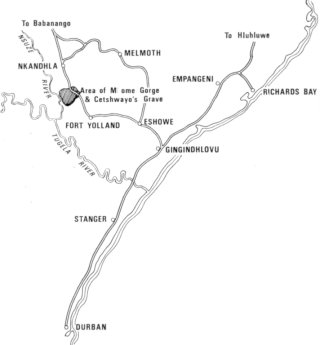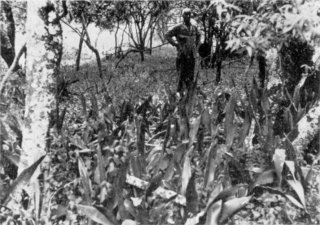

 The South African
The South African
by Ken Gillings.
A meeting was held at "SB" Bourquin's historic old house in South Road to discuss the proposed venture. We arranged to travel in SB's station-wagon, spending the Friday night in the Eshowe caravan park. To minimise cooking and carting stoves with us, we decided to take dry rations.
On D-Day we set off in miserable, wet weather up the Natal North Coast, reaching Eshowe in time to have an informal meeting with the Tugela Commando in their Mess, just behind the jail! This meeting really proved to be to our benefit, as the O.C., officers and men gave us what information and advice they could, regarding the area of the grave. We were told what a devil of a walk we would have and that we were plum crazy because we were not carrying any firearms with us. Most important, however, they told us of a new route, much shorter and not as strenuous as the one we proposed taking past Vumanhlamvu store.

Locality sketch of Mome Gorge
and Cetshwayo's Grave.
Early on Saturday morning, the five of us, SB, Maj. Justin Hulme, Midge Carter, Terry Willson and I broke camp and took the road to Nkandhla via the Forest. At about 65 km we turned left at a district road which eventually reaches Jameson's Drift, in the Tugela Valley. The view from this point was truly magnificent and, far ahead of us, Ntunjambili or Kranskop stood, overlooking the valleys and mountains of this historic part of Zululand. Having descended the mountain, we came across the turnoff quite by chance and proceeded along a shocking road for about 18 km until it seemed that SB's brand new Valiant's undercarriage would be ripped off.
We eventually reached Dimeni store where we packed our rucksacks in preparation for what promised to be a killing hike. We were told that a young girl, in the store at that time, actually lived near the grave and would lead us there.
We set off, painfully aware of the packs on our backs, while the Zulu girl effortlessly carried a 50 lb bag of mealie meal on her head. The locals stopped and stared as we passed and we could hear them discussing the mad abeLungu who had forsaken the luxuries of city life to trek all this way just to visit the grave of the iNkosi.
Soon we crossed our first stream and the countryside became quite hilly so that we contoured as much as we could. The heat also began to take its toll. We crossed numerous rivulets which all joined the Nsuze River, glistening in the sun to our left.
Eventually, we stopped to rest on a hill overlooking the Nkunzane River for 15 minutes or so, while our guide pointed out the site of the grave, hidden behind a hillock in front of us. In the distance, we could see the Qudeni Mountain with, high up on the right, the Forest Ranger's hut. We must have covered approximately 10 km and the grave seemed tantalisingly close.
Having descended to the Nkunzane, which we crossed and recrossed three or four times, we started to round the hillock previously mentioned when, to our surprise, a Zulu emerged from his house and started to blow an unidentified hymn on a trumpet. I thought that this must be the custodian of Cetshwayo's grave, mentioned in Binns' book. In actual fact, he turned out to be one whom we shall call "Young Shezi", practising for Sontweni (Church) the following day!
Young Shezi pointed out the site of the grave which was directly behind
his house. The grave itself was invisible,
being surrounded by a dense grove of indigenous trees and bushes,
probably an acre in area. He told us that, to enter the
sacred precincts of the resting place of the last Zulu King, we would
have to obtain the permission of the guardian who
lived in a kraal high in the hills above us. We thanked him for this
information and, having deposited our packs in one of
his huts, we made our way up the hill, walking only metres from the
grave. About an hour later, we reached the summit and
entered the Old Man's kraal. Fortunately the custodian, "Old Shezi", was
there and, at this stage, we decided to leave the
talking to SB who is a Zulu linguist. After the customary greetings had
been exchanged, the conversation went something
like this:
Old Shezi: "What do you want here?"
SB: "We wish to visit the grave of the King."
Old Shezi: "But you are white men. What do you wish to see the King's
grave for? Why are you carrying those
cameras - are you writing a book?"

The Guardian of Cetshwayo's Grave,
referred to as "Old Shezi" in the text,
seen looking at the Grave.
After a lengthy discussion, SB produced the permission of the Regent (Israel Mcwayizeni) to visit the grave. Seeing this, the old man's son said that, if Israel had given his permission, they could not stop us. The guardian now agreed to escort us, and the atmosphere was completely different. At this stage, I recognised this man as the one kneeling in Binns' photograph of the grave.
Before we could leave, our new friends insisted that we join them in partaking of some uTshwala, or beer, the traditional drink of the Zulus. My views on the taste of this stuff are well known, as are Justin's, but it was only good manners to do what we had been asked, and soon we all sat chatting over glasses of gritty, bitter beer while the Shezi clan discussed our presence.
Prior to our reaching the hut, Justin had pointed out that we were pretty close to the scene of the bloody massacre of Mome Gorge and we decided to visit this site first. Having taken leave of our hosts for the time being, we now made our way to the ridge overlooking the Gorge.
The battle site today leaves much to the imagination. There, to the left, were the gun positions (now marked by the presence of a school building) of the Natal Field Artillery, who pounded Bambatha and his warriors on 10th June 1906. In front of us, the rebels first felt the effects of the well-planned and carefully carried out bombardment, being massacred almost to a man, while to our right the Mome River wound its way out of the Gorge at approximately the spot where Bambatha's body was found. All around, we could picture the Natal Troops silently arriving to surround the rebels, while we were actually standing in the trenches (still four feet deep) occupied by the Transvaal Mounted Rifles. Unfortunately, time was running out and, having taken photographs, we made our way back to Old Man Shezi's kraal.
After pressing us to another shot of uTshwala, this time out of an "ukhamba" or clay pot, this remarkable old man, who must be in his eighties, led us over the hills and through the gullies, until once more we reached the grave. Slowly we entered the sacred grove of trees, and silently followed the guardian to the grave which is situated in the centre of the bush. We soon reached the sacred spot where we eagerly took photographs.
All that can be seen of the grave is a collection of old pieces of metal - the rims, brake and other unidentified bits of the wagon on which Cetshwayo's body was carried after his death on the 8th February 1884. Snake lilies grow in abundance and the atmosphere is as serene as the site itself.
We emerged from the grove and, after thanking the grand old man of Zululand for his help, we returned to Young Shezi's kraal, collected our packs and made our way to the Nkunzane River where we unrolled our sleeping bags. After sitting around a magnificent camp fire for a couple of hours reminiscing and discussing our adventure, we retired (in an area infested with mambas, we were told the next morning!).
Further upstream we visited the site of an old silver mine which ceased production in the 1920s. Here Terry, a former miner, was able to point out items of interest, such as the rollers and crushers, still intact after all these years.
On arrival at the store, we collapsed over a couple of beers. Then loading up, five very satisfied bundu bashers made their way back to Durban, after an unforgettable experience.
Return to Journal Index OR Society's Home page
South African Military History Society / scribe@samilitaryhistory.org